
Over time, when a business is passed down through generations within a family, there’s often an assumption that the family has consistently delivered high-quality services with expertise.
The situation at the Lamb Funeral Home, located on Orange Grove Boulevard in Pasadena, California, demonstrated that appearances can often be misleading.
For decades, generations placed faith in a mortuary founded by Charles F. Lamb in 1929 to handle their deceased family members’ remains. However, it was uncovered in 1986 that numerous individuals who had paid for cremation services were not receiving the expected results.
Moreover, there persisted a recurring rumor – explored in HBO’s recent documentary series titled “The Mortician” – that the founder’s great-grandson David Sconce may have played a role in eliminating a business competitor who was edging closer to uncovering the truth.
The Funeral Director has been delving into the peculiar tale with assistance from Sconce, who served 10 years in prison due to probation violation following a complex series of legal proceedings. Despite asserting that he did not murder anyone, he maintains an unyielding stance regarding events occurring at the crematorium during his tenure.
In his routine practice of cremating multiple bodies at once, Sconce expressed that mixing the ashes is not significant for him, because it meant that families wouldn’t receive only the ashes of their specific loved one. He further stated that he doesn’t assign any worth to anyone after they have passed away, and people shouldn’t do so when it’s his turn. In his perspective, once a person is deceased, they are no longer an individual.
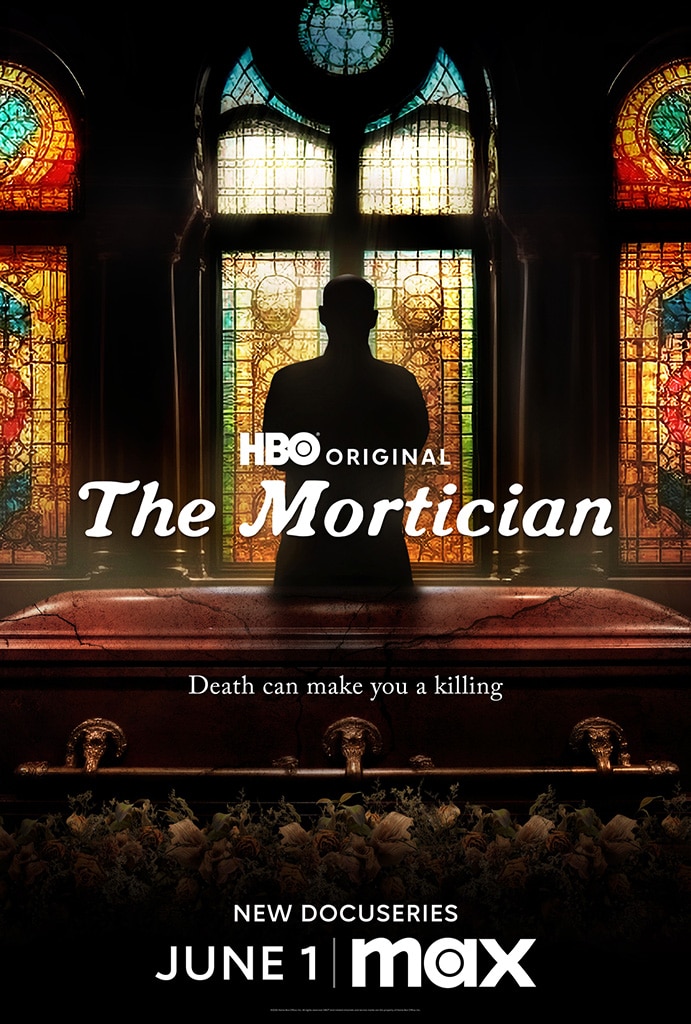
At that point, he expressed concern over being discovered, as he explained, since the act – which Sconce claimed is prevalent within the cremation industry – was considered illegal according to the state’s Health and Safety Laws.
In response to “The Mortician”, the National Funeral Directors Association stated that while the events depicted in this documentary are indeed shocking and authentic, they do not represent the overall nature of the funeral industry as a whole.
The organization emphasized on May 30th that the focus of this documentary does not encompass the entire funeral profession. In reality, countless funeral directors are working tirelessly day in and day out to aid families as they begin their journey towards healing after losing a loved one. With empathy, respect, and honesty, these professionals assist families in organizing heartfelt funerals and memorials that truly encapsulate the unique qualities, preferences, and life experiences of the deceased.
In the series, the character defended his actions with a misguided sense of justification, implying that he considered the people involved as unimportant. He often dealt with cases of ships sinking at sea, which typically received little attention or interest from others.
Concerning the returned remains, Sconce emphasized that the contents of the urn were not significant. He suggested that people should manage their feelings better because what is in the urn is no longer their loved one; it was never their loved one in the first place. Show affection while they’re alive, full stop.
However, merely confusing ashes was only a minor part of a much larger issue. Here’s an astonishing tale about “The Undertaker”:

In the 1920s, Charles F. Lamb established the Lamb Funeral Home in Pasadena, California. His son, Lawrence C. Lamb, assumed control of the business in the 1950s. Later, in the 1980s, Laurieanne Lamb and her husband Jerry Sconce took over as owners.
At the same time, Laurieanne and Jerry managed the mortuary, their son David Sconce oversaw the cremation services, which were offered at a different location they owned – the Pasadena Crematorium, situated in the neighboring town of Altadena.
Speaking about her ex-spouse in the series “The Mortician,” Barbara Hunt shared that he was amusing, enjoyable, and had a charming family. She expressed that she was instantly smitten and quickly fell in love with him.
Looking back, Hunt added, it struck her as unusual that her fiancé’s grandparents, Lawrence and Lucille Lamb, both inquired on their wedding day whether she was absolutely certain about marrying Sconce. Moreover, her future father-in-law expressed to her, “You have the option to step back.
She found it quite unusual, yet it didn’t deter her, as she reminisced. Her desire to wed him remained strong.
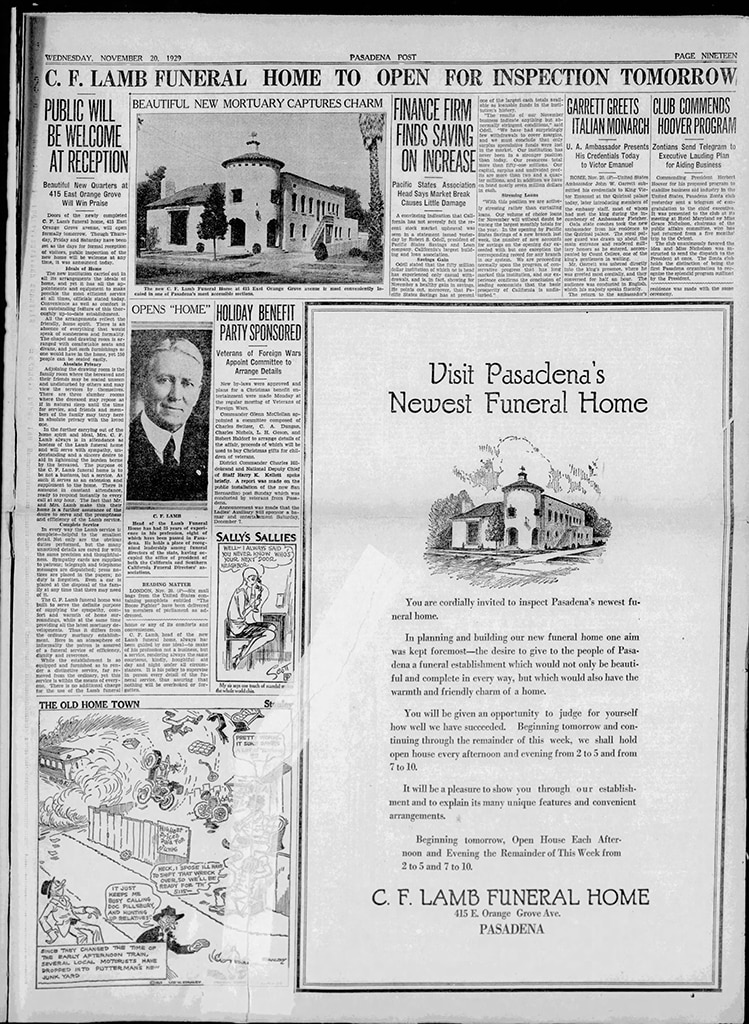
Starting around 1982, Sconce expanded its services to provide cremation options not only for Lamb customers but also for other funeral homes. This detail is recalled in “The Mortician” by Jay Brown, the owner of Mountain View Mortuary and Cemetery. The Pasadena Crematorium, located on the Mountain View property, was where Sconce seemed like a friendly individual according to Brown’s account.
In the show, Sconce removed seats from an aged Dodge van and traveled across Southern California, ranging from Santa Barbara to San Diego. He casually mentioned that he was collecting deceased individuals.
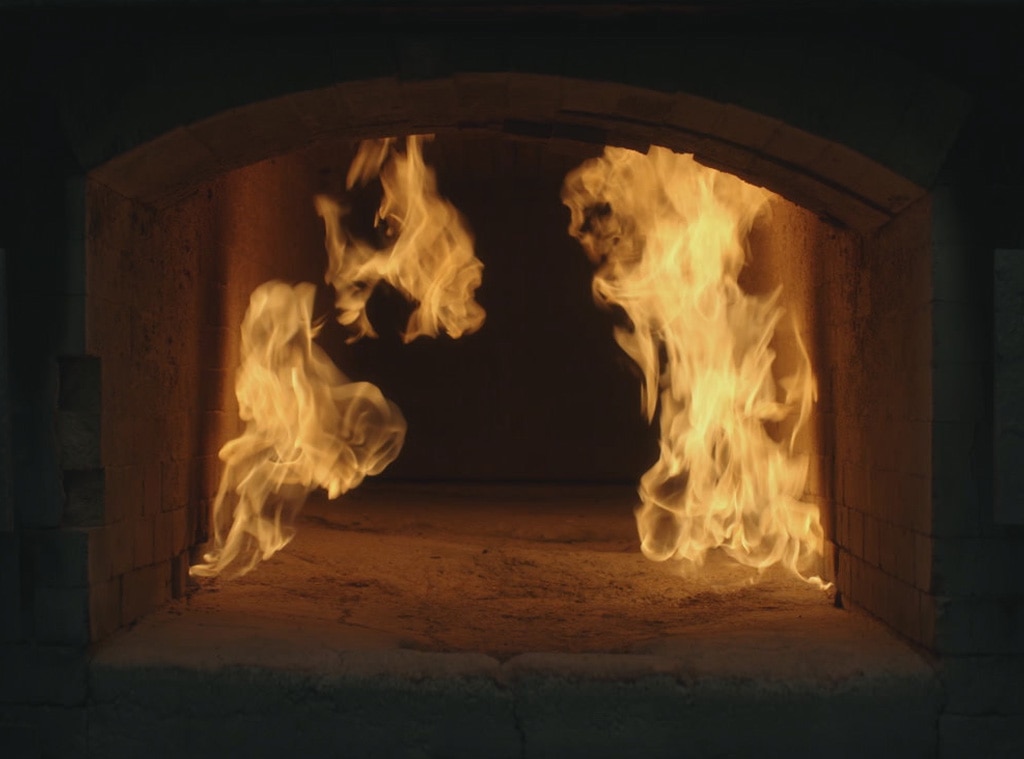
Operating under Coastal Cremations Inc., he was billing $55 for each service, which he clarified as a single deceased individual. This fee encompassed both the cost of a cardboard urn for the returned ashes and the expense of diesel fuel required to operate the two-oven crematorium, as Brown pointed out. Sconce’s prices, according to Brown, were significantly lower than those offered by other local businesses.
Johnny Pollerana, who was previously employed at the crematorium run by Sconce, mentioned in “The Mortician” that his supervisor managed to make the situation appear entirely routine as they started fitting up to 15 bodies into each oven at once instead of just two or three.
In the series, it’s stated that The Lambs conducted 194 cremations in 1981 prior to Sconce assuming control, and then 1,675 in 1982 during his management. This figure increased to 3,487 in 1983, followed by 4,350 in 1984, and peaked at 8,173 in 1985 under Sconce’s leadership.
In the show “The Mortician”, they stated, “I can handle one body in two hours, or multiple bodies, up to ten, and it takes an additional half hour. Essentially, the number of bodies doesn’t affect the time; the process remains the same.” This might sound harsh, but the implication is clear: the time required doesn’t change regardless of the number of bodies.
Back in the 1980s, he drove a white Corvette with the license plate I BRN 4U.
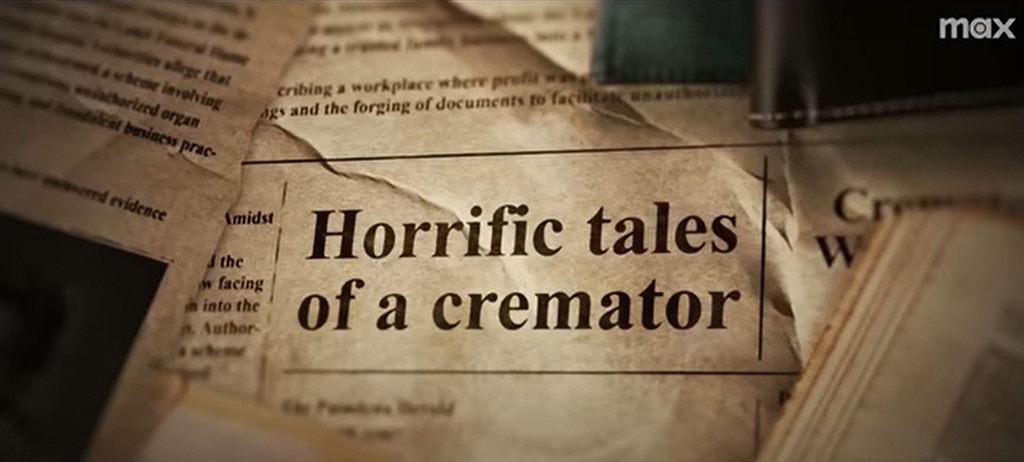
Apart from mixing the remains, as Sconce described it, authorities found that he routinely extracted gold teeth and fillings from deceased persons’ mouths prior to their cremation. Later on, Sconce was accused of stealing dental gold.
In the series, Pollerana stated that he declined to chop something when Sconce inquired. Consequently, it was his superior who took care of the task instead.
Meanwhile, according to Sconce, his employees carried out the task over time, whereas he performed it on multiple occasions due to family requests. The family asked for it to be returned; the reason is uncertain.
He told police in 1987 that he did not sell gold.
Further probing during the investigation revealed that the Lamb Funeral Home had been taking organs without the necessary consents.
OR
Investigations following the crime found out that the Lamb Funeral Home was illegally removing organs without proper permission.
OR
The criminal inquiry that followed discovered that the Lamb Funeral Home was involved in unauthorized organ harvesting.

In the show, Sconce shares that seeing a cornea extraction on a body he was set to retrieve sparked his idea for a continual source of viable parts. Consequently, he established the Coastal International Eye & Tissue Bank, Inc., where he served as the executive director.
In the show, Sconce expressed that it seems irrational to discard items when they could benefit others. Specifically, he mentioned that he has the opportunity to earn $500 for brains, $750 for hearts, and $100 for lungs from a biological supply company he works with.
Previously, the ex-funeral director attributed his prioritization of wealth over ethics in his profession to his genealogy (or family background).
Mentioning that his deceased grandfather Lawrence, back in 1991, was the one who would assemble our family for holiday photos and ask us to shout out “money!”, Sconce commented, “This tradition has been passed down through generations, so if you want an analogy, it’s like the tainted source of a case or issue.
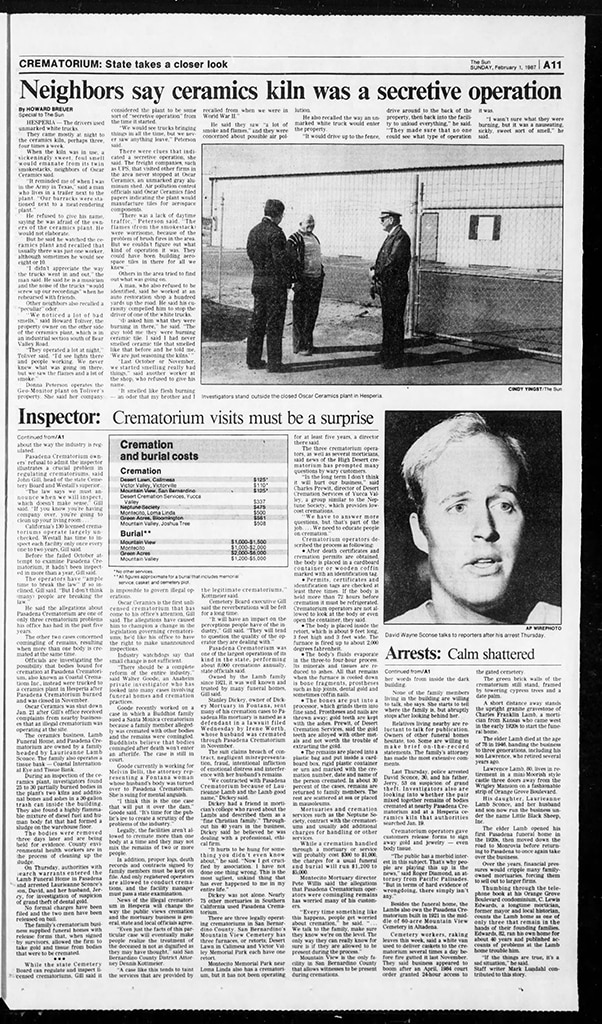
In my role as a lifestyle expert, let me share an intriguing tale from the past. On November 23, 1986, a tragic incident occurred at the Pasadena Crematory. The story goes that an employee was conducting routine tasks, which involved firing up the ovens. He then decided to step away for a moment, seeking a change of pace, and unfortunately dozed off. This account was shared anonymously in a series, with the speaker’s face concealed.
In “The Mortician,” Sconce exclaimed, reminiscing about receiving a call from Pollerana regarding the crematorium fire. “I discovered they lit up their marijuana and departed!” He couldn’t find the right words to express his feelings.
In just under two months’ time, the San Bernardino County Air Pollution Control Agency started receiving reports of odd smoke, flames, and odors emanating from Oscar Ceramics in Hesperia, California (approximately 70 miles east of Pasadena). These complaints even included one from a World War II veteran who identified the source.
In 1988, Hesperia Fire Chief Will Wentworth recounted to the Los Angeles Times an unusual incident where he assured a caller that what they were smelling was unlikely human flesh. However, the caller retorted: “You’re not convincing me that it’s not the scent of burning corpses. I had firsthand experience with the ovens at Auschwitz.
On January 20, 1987, when San Bernardino County Sheriff’s deputies and other officials stormed into the ceramics factory, then-Sergeant David Dicus stated in the series that they discovered numerous bodies being cremated simultaneously in pottery kilns.
According to Pollerana, they were incinerating nearly 200 corpses simultaneously during the period when they decided to close the operation. (Show: “When they came to shut us down.”)
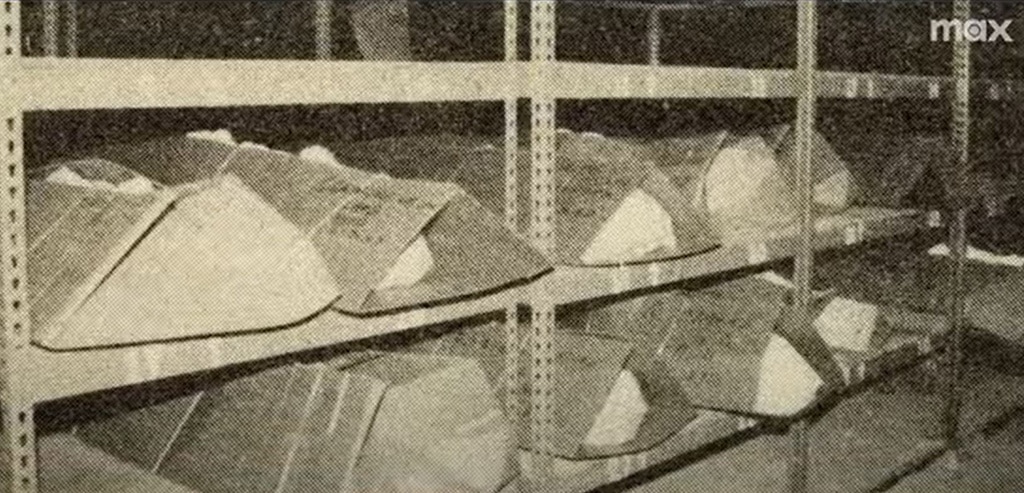
However, despite being against the law to cremate numerous bodies simultaneously and the grisly news stories that followed the discovery in Hesperia, it was still considered a minor offense, classified as an infraction.
Reflecting on the situation, Dicus stated in “The Mortician” that they hadn’t realized the extent of it at the time. The San Bernardino Sheriff’s deputies carried out a search at Lamb Funeral Home, and Laurieanne, Sconce’s mom, was described as the friendliest person you’d ever meet. She was open to conversation, Dicus emphasized, and appeared oblivious to the events unfolding around her.
Upon peering into the refrigerated section, they discovered “numerous deceased individuals swathed in cardboard,” as Dicus explained, along with dismembered body parts. He described the scene as “grim,” but his mind immediately questioned, “Why are these legally deceased individuals assembled here?
In 1987, Sconce explained to a TV journalist that there were no questionable activities associated with the operations in Altadena or Hesperia. He also expressed that they have been severely misrepresented, misunderstood, and unfairly criticized by the media for nearly a week.
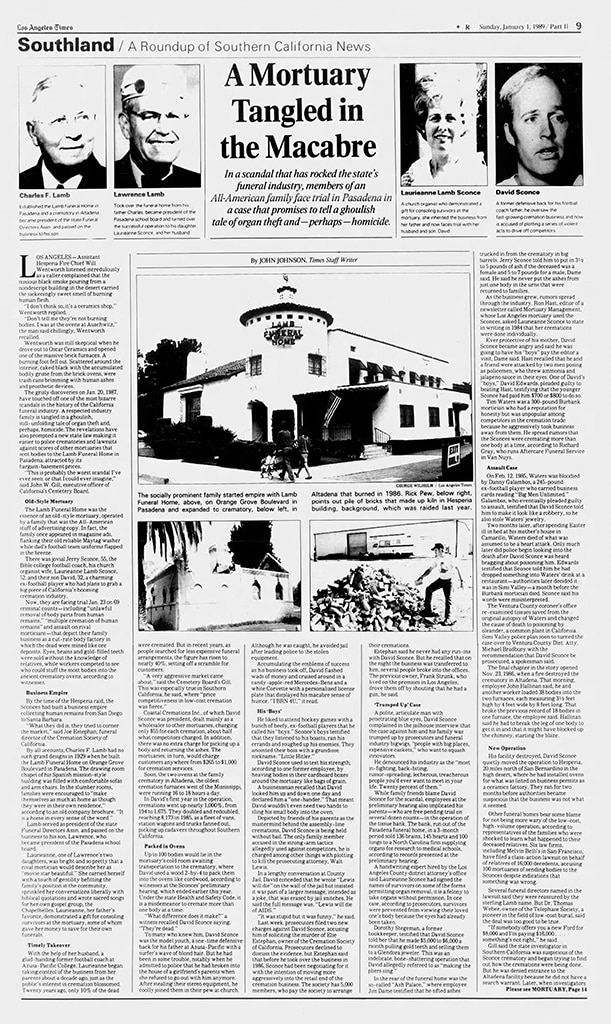
Ultimately a routine audit was the nail in the coffin for the Lamb Funeral Home.
In 1986, an auditor named Skip Jones, working for the California Funeral Board, discovered during a review of the company’s financial records that they were not correctly managing money set aside in trust accounts for future mortuary services, which had been paid in advance by clients.
In the book “The Mortician,” Jones stated that out of all the accounts she received payment for, a total of 170 had gone unreported. He mentioned that Laurieanne vowed to establish an account right away and disclose everything to the Consumer Financial Bureau. Jones further expressed that he saw no reason not to trust her word on this matter.
According to Jones, it was discovered the next year that she hadn’t carried out her obligations, as instead, the funeral home had accumulated approximately $90,000 in interest on funds belonging to their clients.
In my role as a lifestyle expert, I must share some shocking news that has recently unfolded in our community. I, along with my parents, have found ourselves in the center of an alarming situation. We’ve been accused of embezzling funds, organ harvesting, and multi-cremation – charges that are indeed hard to comprehend for many, including myself.
The legal system has set bail at a modest $5,000 for both my mother and father, and they have since been released, awaiting their trial. However, the situation is quite different for me. Due to the unique circumstances surrounding these allegations, my bail was set at an astounding half a million dollars. I am currently working diligently with my legal team to ensure a fair outcome as we navigate this challenging time together.
“So,” he recalled in the series, “they swoop in and took me right to jail.”
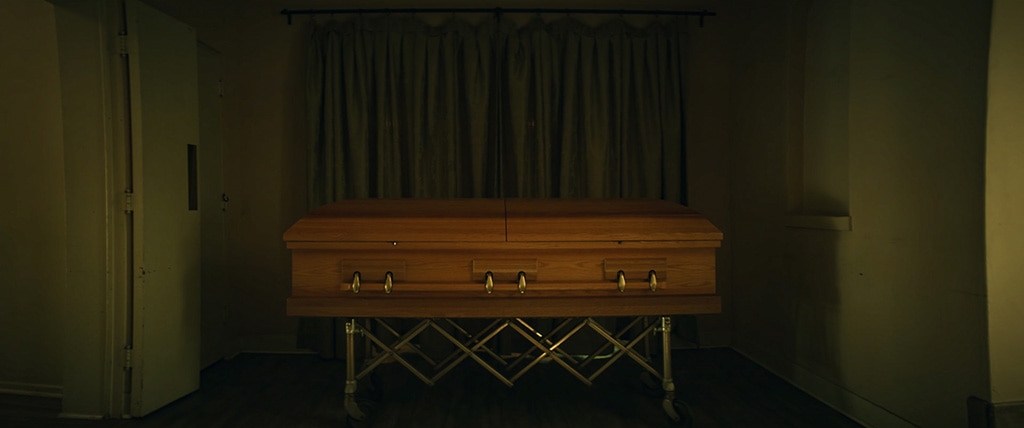
On the 12th of February, 1985, Tim Waters, who was the proprietor of budget cremation service The Alpha Society located in Burbank, California, suffered a violent attack at his workplace.
Before that point, it was commonly known among many within “The Mortician” community, he had been vocal in his criticism of Sconce.
In the series, Greg Abbott, editor of Mortuary Management magazine, commented that the prices offered by Sconce seemed unusually low. “Tim realized that the only possible explanation for this was a high volume of sales,” Abbott stated. “Later on, Tim began expressing his doubts about David to people in the industry.
On April 8, 1985, Waters died of what an autopsy concluded was a heart attack. He was 24.

A local resident stated that he observed two individuals loitering in a car near his workplace, apparently eating and discarding their garbage outside the window at roughly the same time as the Waters assault occurred. The Burbank police department collected this waste and kept it in an evidence storage room. This trash remained untouched until 1987, when Sconce became a subject of investigation.
As a lifestyle expert, I’d like to share an intriguing piece of information: traces left behind on a humble carton of milk, found amidst discarded items, surprisingly led us back to none other than Danny Galambos – a valued employee at the scene.
As a lifestyle expert speaking directly, let me clarify a point: I’ve never crossed paths with Tim Waters, either in person or over the phone. In fact, I didn’t recognize him until his picture was presented to me. To set the record straight, he was not one of my accounts.
In a June 1989 court hearing over accusations against Sconce, Galambos stated (as reported by the Los Angeles Times) that his superior had hired him, along with two others, to physically assault Waters as retaliation for supposedly spreading damaging gossip about Sconce’s business. Galambos admitted his guilt in Pasadena Superior Court for the attack on Waters and two other competitors; he was given five years of probation as punishment.
During their investigation, detectives found out that Waters’ autopsy didn’t involve a toxicology screening. In 1987, further tests revealed the presence of oleander, a potentially deadly plant common in Pasadena gardens, within his body. Consequently, his cause of death was revised to oleandrin poisoning and the manner of death was changed to a homicide.
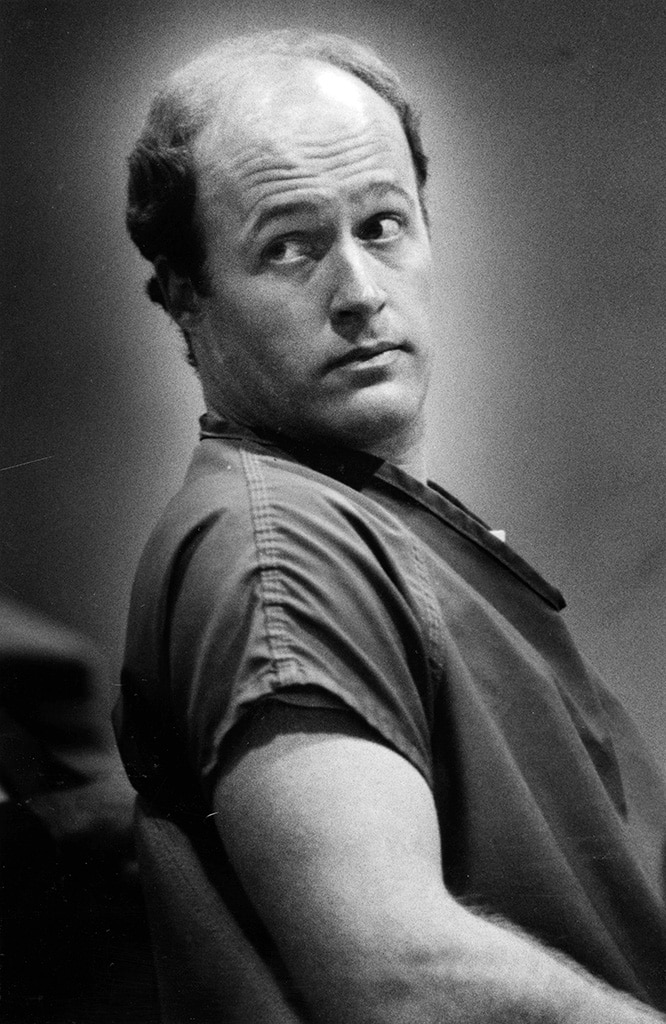
Initially, Sconce and his family were charged with a total of 67 criminal offenses, such as misappropriating funeral trust funds, illegally taking body parts from deceased individuals, stealing dental gold, forging organ donation consent forms, and improperly cremating human remains on multiple occasions.
At a preliminary hearing, several accusations were dismissed, and the prosecution streamlined the case even more as they prepared for the upcoming trial.
Despite the opposition of prosecutors to a plea agreement, in September 1989, Sconce admitted guilt in Pasadena Superior Court for 21 charges, which included desecrating bodies, performing large-scale cremations, and hiring individuals to assault three competing morticians.
In September 1989, Sconce confessed to multiple crimes including body desecration, mass cremations, and hiring thugs to attack three rival morticians, despite the prosecutors’ objections to a plea deal.
He was sentenced to five years in prison. He had been facing 11 years if his case went to trial.
Deputy District Attorney Nancy Aronson expressed to the LA Times that they weren’t completely dissatisfied with the result following the plea entry. She pointed out, “This individual has been maintaining his innocence up until now, but he ultimately admitted guilt. It undoubtedly spared the taxpayers and everyone a significant amount of time.
Simultaneously, Sconce was accused of plotting to hire an assassin to eliminate a prospective buyer of another funeral home. However, the judge dismissed this case. Yet, if prosecutors succeeded in their appeal, Sconce would be given the chance to admit guilt and receive a sentence of lifetime probation instead.
Here’s what transpired: In 1997, according to the Associated Press, Sconce admitted guilt in a murder plot and was sentenced to lifelong probation.

In April of 1990, Sconce denied guilt in relation to the murder charge connected to Waters’ death in 1985. This was reportedly the nation’s first known case of poisoning by oleander, according to Harvey Giss, Ventura County Deputy District Attorney, at that time.
At an initial court appearance in October, Galambos stated that when Sconce asked him to attack Waters, the plan was to stage it as a robbery… [Sconce] mentioned if by chance we ended up killing him, he could handle disposing of the body, perhaps by burning it.
Galambos also stated that Sconce informed him he had “poisoned ‘the person you handled a short while back,'” in reference to the assault.
Nonetheless, it was admitted by prosecutors that they hadn’t found enough evidence to confirm a meeting between Sconce and Waters on the day when the latter became unwell and eventually passed away.
In April 1991, the trial was scheduled but the charges against Waters were dismissed by the prosecutors. This decision was made after further examination of Waters’ exhumed body which raised questions about the initial diagnosis of oleander poisoning as the cause of death. Kevin DeNoce, a Deputy Ventura County District Attorney, explained at the time that although the first expert had found traces of oleandrin, the inconsistencies in the results created a reasonable doubt that warranted dropping the charges.
Decades later, Sconce maintains he had nothing to do with Waters’ death.
In the book, “The Mortician,” Sconce stated, “I believe I crossed paths with him only once during my lifetime, and beyond that, we never had any contact. That’s all there is to it.

At their trial, Laurieanne and Jerry claimed they were not guilty – instead, they implicated their son as the culprit.
According to Edward A. Rucker, their attorney, it was their son, David, who performed grisly actions such as extracting gold teeth, which has led to a heartbreaking situation for them, affecting a long-standing family business for the third generation and the families of the departed. (LA Times)
However, the jury didn’t accept their claim of ignorance about the events unfolding right under their supervision. In April 1995, as reported by the LA Times, Jerry was convicted on one charge of conspiring to misappropriate parts and one charge of misusing $100,000 from a trust account, but was acquitted of four charges involving the illegal removal and selling of body parts before cremation.
Laurieanne was found guilty in relation to three out of four charges involving illegally permitting the extraction of eyes, hearts, lungs, and brains from bodies before they were cremated, as well as three counts where she falsified customer signatures on organ donation and cremation consent documents.
They were each sentenced to three years and eight months in prison.
In court, Judge John Ouderkirk stated, “They deceitfully did it to swindle the affections of the deceased and shatter the emotions of the living.” Essentially, they were defrauding the grieving for financial gain. The couple attempted an appeal but ended up serving their entire sentences in full.
Jerry passed away in the year 2019 at the ripe old age of 85. Currently, Laurieanne, who is now well into her senior years, prefers to live quietly and has chosen not to be part of “The Mortician”.
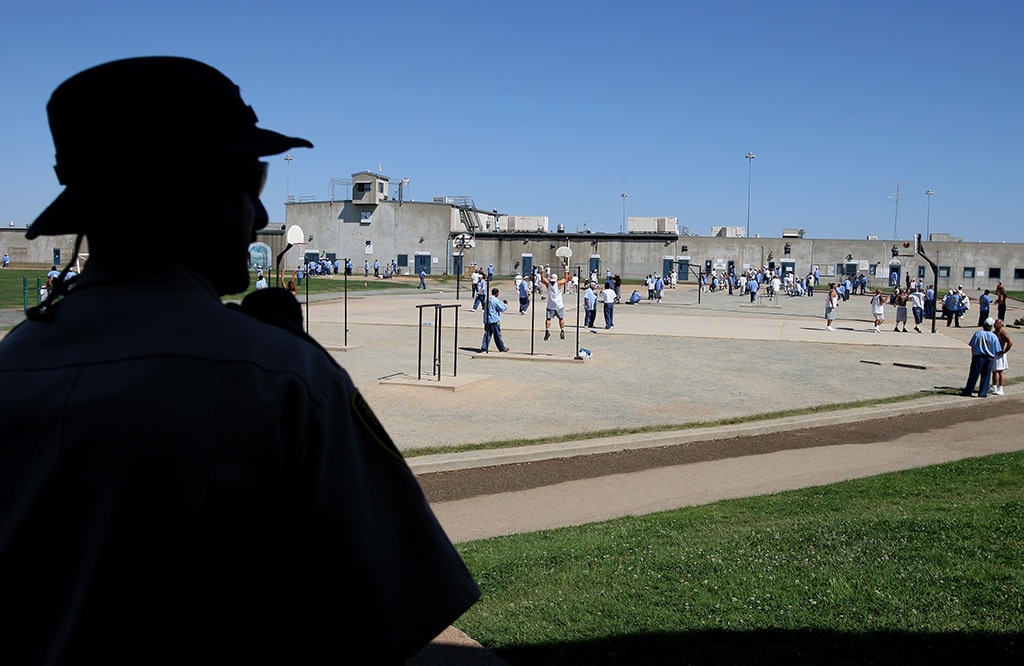
After serving approximately half of a five-year prison term, the sconce found himself frequently entangled in legal issues.
In 2012, he received a five-year probation sentence in Montana due to a federal charge of having a firearm as a felon. He claimed his neighbor had given him the rifle for protecting his pets from wolves. Afterwards, he opted not to contest extradition to California, where he faced charges for several parole violations.
In 2013, I admitted my guilt for breaching a lifelong probation agreement stemming from an attempted murder-for-hire conviction in 1989. As a result, I was given a sentence of 25 years to life in prison.
In the context of that case, his lawyer, Roger Diamond, contended that the life sentence wasn’t justified. According to the San Diego Union-Tribune, he emphasized that this individual had never encouraged anyone to commit murder, and no one had lost their life due to his actions.
In delivering the substantial verdict, Judge Dorothy Shubin explained that since it had been established that Sconce was not allowed to have a firearm for any reason, having one was a conscious decision on Mr. Sconce’s part. The Associated Press reported this, and Prosecutor Thomas Krag described it as a “serious breach of his probation.
In the courtroom, Sconce admitted, “I acted in a manner I shouldn’t have. It’s my duty to own up to my actions.
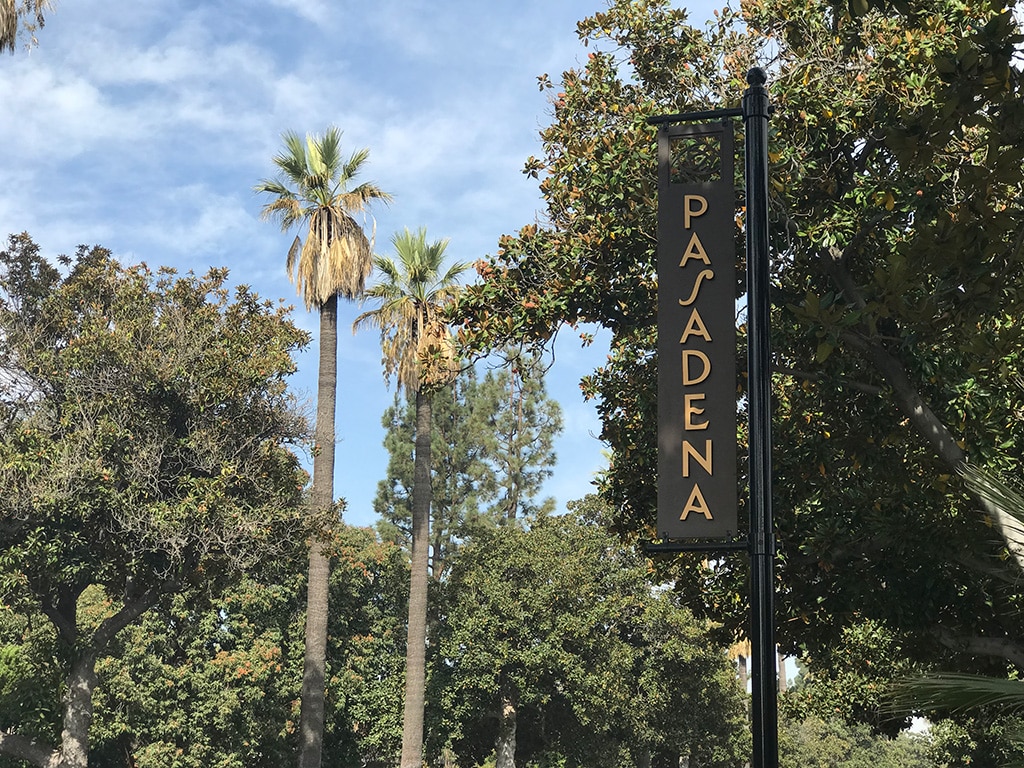
The California Funeral Board revoked the Lamb Funeral Home’s license in February 1989.
Simultaneously, as reported by the Los Angeles Times, the College Football Board granted a fresh license to Lamb Management Company, a venture now managed by brothers Bruce Lamb and Kirk Lamb – individuals previously uninvolved in the business run by their sister Laurieanne and brother-in-law Jerry. They subsequently rebranded the enterprise as Pasadena Funeral Home.
Currently, what was once the traditional Lamb Funeral Home has been transformed into a location offering morbid amusement, featuring guided tours through its mortuary areas and an engaging escape room challenge.
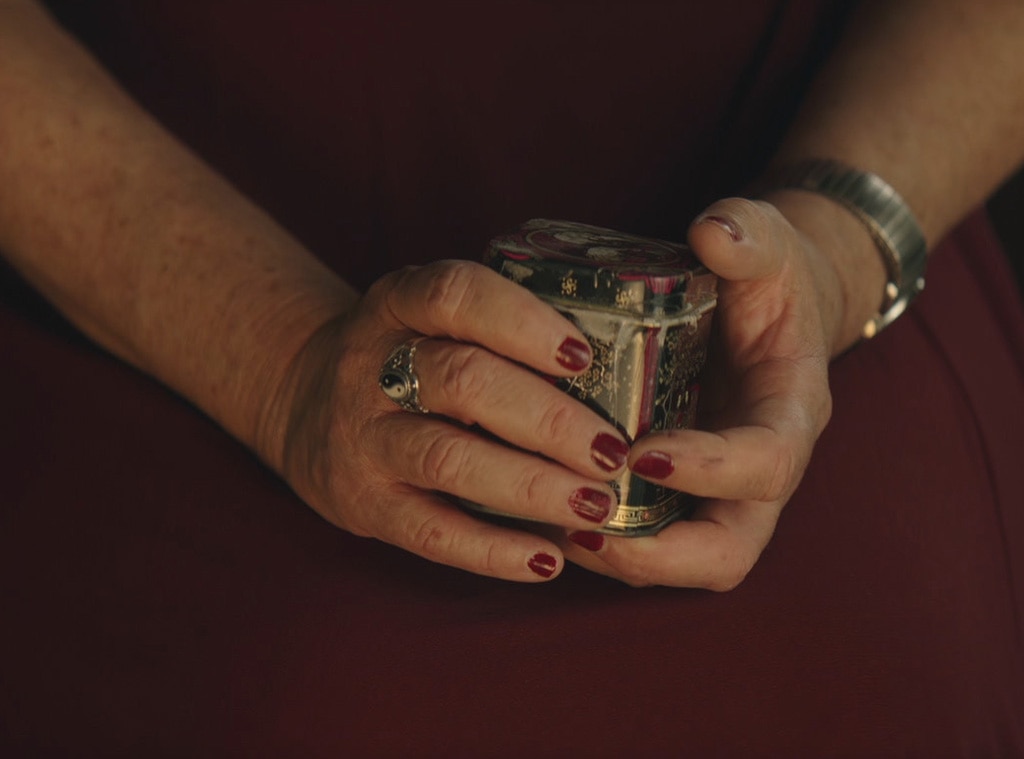
A lawsuit brought on behalf of the families of over 5,000 deceased individuals who utilized cremation services from Sconce (even those whose arrangements were managed by other funeral homes that outsourced their cremations to Sconce) was resolved in February 1992 for a sum of $15.4 million.
A large number of affected individuals were unaware that there might be an issue with the remains of their cherished ones until they learned about the discoveries in Hesperia and the subsequent accusations through news reports.
Darlynn Branton-Stoa expressed her profound shock and sadness, stating, “David Sconce is a monster, he’s truly wicked.” She made this statement in the context of The Mortician after bringing her father’s body to Lamb Funeral Home for cremation following his death in September 1986.
Nancy Hathorn, the one who entrusted Lamb Funeral Home with the handling of her father’s cremation, revealed in the series that she subsequently discovered they had initially taken out his brain and eyes before the process.
She remarked, ‘Discovering they had collected anyone or anything, leaving it behind in the desert where they scattered his remains, was truly heartbreaking.’
Hathorn remarked, “Our family was taken aback, for my father was frequently hospitalized and subjected to examination without his consent. It wasn’t something we approved of.

68 years old now, Sconce got out of Mule Creek State Prison in 2023 and took part in “The Mortician,” an episode that will air for the first time on HBO on June 15.
He expressed his disbelief, saying on the program, “I’m still stunned by my release from detention.” He added, “It’s hard for me to accept that someone is finally showing concern about things I’ve known for such a long time.
Despite openly discussing actions like cramming bodies into furnaces, mixing their remains, extracting gold from dead bodies, and trading body parts, he claims that he never intentionally harmed any living individuals.
Read More
2025-06-14 15:18